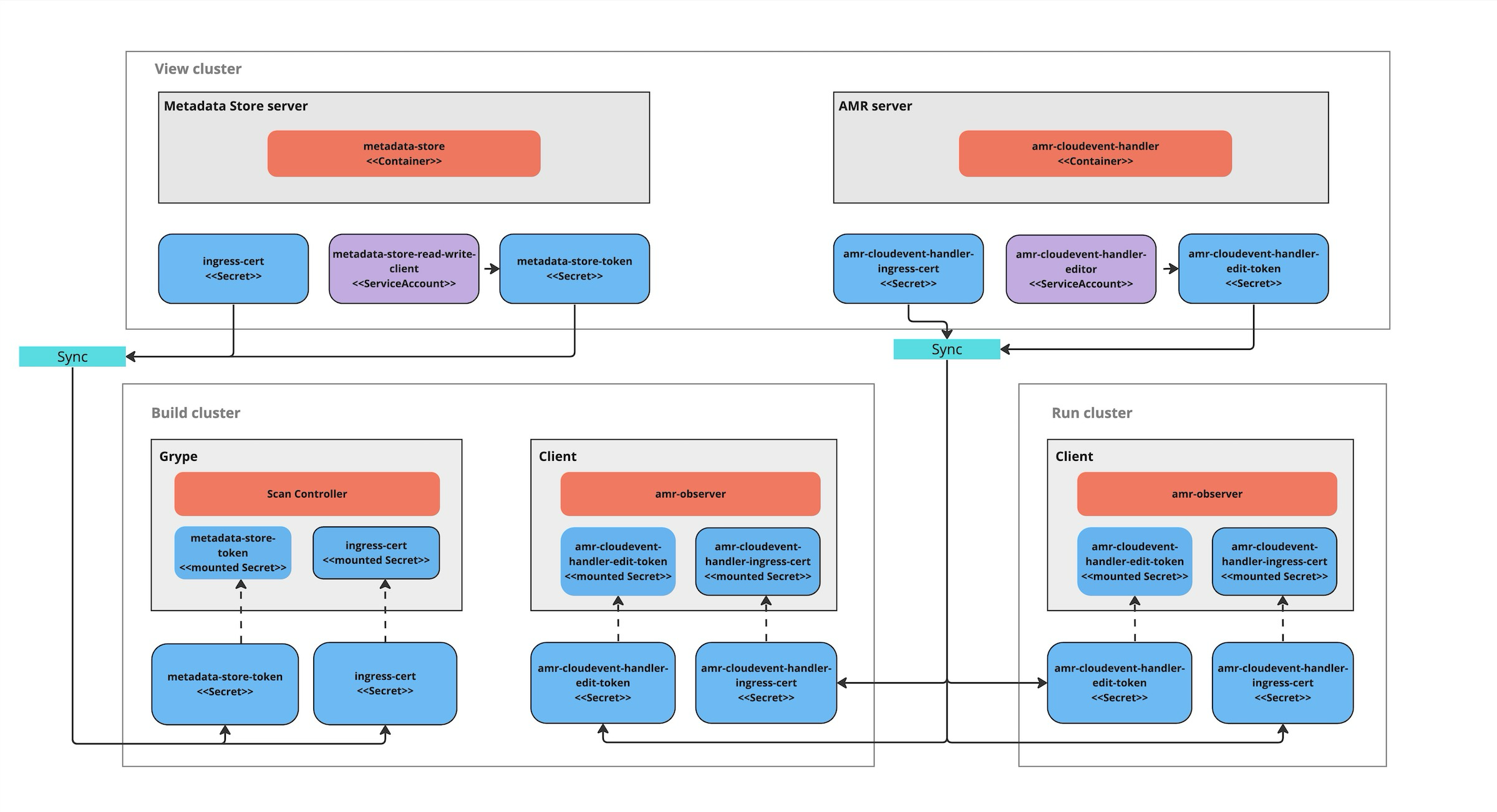Set up multicluster Artifact Metadata Repository (AMR)
This topic describes how you can configure Artifact Metadata Repository (AMR) in a multicluster setup. This is necessary when installing multiple profiles such as View, Build, Run, and Iterate.
NoteThis topic assumes that you are using SCST - Scan 2.0, as described in Add testing and scanning to your application. If you are still using the deprecated SCST - Scan 1.0, you must follow the steps in this topic and the extra steps required for SCST - Scan 1.0 in Set up multicluster for Scan 1.0.
Overview
After installing the View profile, but before installing the Build profile and Run profile, you must copy some configurations from the View cluster to the Build and Run Kubernetes clusters. This topic explains how to add these configurations, which allow components in the Build and Run clusters to communicate with AMR in the View cluster.

Before you begin
You must first install the View profile. This installation automatically creates the CA certificates and tokens necessary to talk to the CloudEvent Handler.
Procedure summary
To deploy AMR in a multicluster setup:
- Copy the AMR CloudEvent Handler CA certificate from the View cluster
- Copy the AMR CloudEvent Handler edit token from the View cluster
- Apply the AMR CloudEvent Handler CA certificate and edit token to the Build and Run clusters
- Install the Build and Run profiles
Copy the AMR CloudEvent Handler CA certificate data from the View cluster
With kubectl targeted at the View cluster, you can get the AMR CloudEvent Handler TLS CA certificate’s data by running:
CEH_CA_CERT_DATA=$(kubectl get secret -n metadata-store amr-cloudevent-handler-ingress-cert -o json | jq -r ".data.\"ca.crt\"" | base64 -d)
Copy the AMR CloudEvent Handler edit token from the View cluster
Copy the AMR CloudEvent Handler token into an environment variable by running:
CEH_EDIT_TOKEN=$(kubectl get secrets amr-cloudevent-handler-edit-token -n metadata-store -o jsonpath="{.data.token}" | base64 -d)
You use this environment variable in the next step.
Apply the CloudEvent Handler CA certificate data and edit token to the Build and Run clusters
After you copy the certificate and tokens apply them to the Build and Run clusters before deploying the profiles.
Build cluster:
- CloudEvent Handler CA certificate
- CloudEvent Handler edit token
Run cluster:
- CloudEvent Handler CA certificate
- CloudEvent Handler edit token
You can apply the CloudEvent Handler CA certificate and edit the token to the Build and Run clusters. These values must be accessible during the Build and Run profile deployments.
- Update kubectl to target the Build cluster.
-
If you already installed the Build cluster, skip to the next step. Otherwise, create a namespace for the CloudEvent Handler CA certificate and edit token by running:
kubectl create ns amr-observer-system -
Update the Build profile
values.yamlfile to add the following snippet. The code configures the CA certificate and endpoint. Inamr.observer.cloudevent_handler.endpointyou specify the location of the CloudEvent Handler that was deployed to the View cluster. Inamr.observer.ca_cert_datayou paste the content of$CEH_CA_CERT_DATA, which you copied earlier.amr: observer: auth: kubernetes_service_accounts: enable: true cloudevent_handler: endpoint: https://amr-cloudevent-handler.<VIEW-CLUSTER-INGRESS-DOMAIN> ca_cert_data: | <CONTENTS OF $CEH_CA_CERT_DATA> -
Create a secret to store the CloudEvent Handler edit token by running:
kubectl create secret generic amr-observer-edit-token \ --from-literal=token=$CEH_EDIT_TOKEN -n amr-observer-systemThis command uses the
CEH_EDIT_TOKENenvironment variable. -
Repeat the earlier steps, but configure kubectl to target the Run cluster instead of the Build cluster.
The Build and Run clusters now each have a CloudEvent Handler CA certificate and edit token named amr-observer-edit-token in the namespaces metadata-store-secrets and amr-observer-system. Now you are ready to deploy the Build and Run profiles.
Install the Build and Run profiles
If you came to this topic from Install multicluster Tanzu Application Platform profiles after installing the View profile, return to that topic to install the Build profile and install the Run profile.